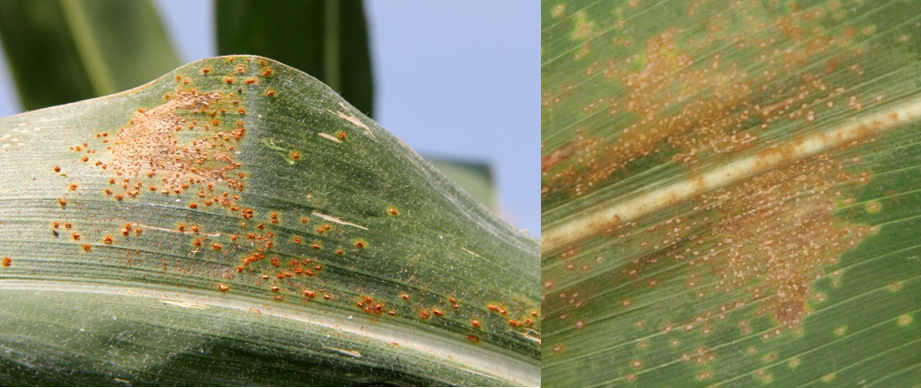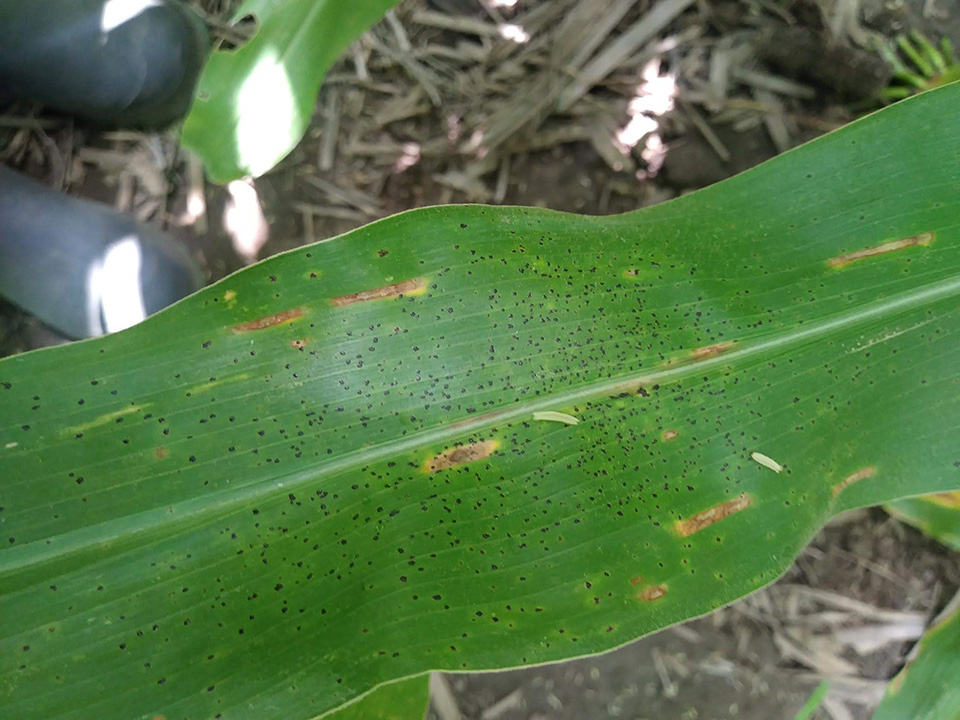Southern Rust: Southern rust was officially confirmed in Posey County this week. We currently have two positive counties and one probable in Indiana. We need your help – if you are out scouting field in the surrounding counties please let us know if you find any suspect samples. If you are unsure and want to email me a preliminary image before sending a sample to the Purdue Plant Pest Diagnostic Lab you can at dtelenko@purdue.edu. As a reminder, here is a link for submitting a sample to the PPDL https://ag.purdue.edu/btny/ppdl/Pages/Submit-A-Sample.aspx
Southern rust pustules generally tend to occur on the upper surface of the leaf, and produce chlorotic symptoms on the underside of the leaf (Figure 2). These pustules rupture the leaf surface and are orange to tan in color. They are circular to oval in shape. We are seeing a lot of common rust as well and both diseases could be present on a leaf.
There are a few characteristics to use to try to distinguish southern rust from common rust. Common rust will form pustules on both sides of the leaf. In addition, common rust pustules tend to be spread out across the leaf, and less densely clustered. Common rust pustules have a brick red to brown coloration and may be more elongated than southern rust pustules.
Check out the southern rust publication for more images of southern rust and other diseases that might mimic it. This publication also has good information on determining when a fungicide application will be beneficial. The publication is at following link: https://crop-protection-network.s3.amazonaws.com/publications/cpn-2009-southern-rust.pdf.

Figure 2. Southern rust pustules on corn leaf, and chlorosis on the underside of the leaves. Pustules generally form and erupt on upper surface. (Photo Credit: A. Sisson, Iowa State University at https://cropprotectionnetwork.org/resources/articles/diseases/southern-rust-of-corn)
Tar Spot: There has been no additional counties added for tar spot this week in Indiana. Michigan, Illinois, and Iowa have all now confirmed at least one county (Figure 3). In Indiana, at sites where tar spot was found last week we have started to see secondary infection (Figure 4) and more tar spot developing in the lower canopy. Most locations still show very unfavorable conditions for tar spot to develop. We again are requesting if you have any suspect locations to please update us and send a sample. I am especially interested in surrounding counties such as Lake, Jasper, Pulaski, St. Joseph and Starke or anything in the northern part of Indiana.

Figure 3. Distribution of tar spot of corn as of July 25, 2019. Source: https://corn.ipmpipe.org/tarspot/.
Both gray leaf spot and northern corn leaf blight are also active in the lower canopy of corn across the state. It is going to be extremely important to be out scouting, especially if you are trying to make a decision on a fungicide application. We just release and article discussing the factors that should be considered due the late planting. See Mueller, et al. Foliar Fungicide Decisions for Late-Planted Crops. https://cropprotectionnetwork.org/resources/features/foliar-fungicide-decisions-late-planted-crops
As a reminder the field history, disease activity, hybrid susceptibility, weather conditions, the price of corn, and cost of fungicide application are factors that should be considered in making a decision to apply a foliar fungicide.
Due to the need to monitor both southern rust and tar spot in Indiana, there will be no charge for southern rust and tar spot samples submitted to the PPDL for diagnostic confirmation. This service is made possible through research supported by the Indiana Corn Marketing Council.
We will continue keeping a close eye on risk models and intensely scouting more fields. I am interested in adding more locations in surrounding counties in northern Indiana; please contact me if you are interested in helping. Please feel free to contact me at (dtelenko@purdue.edu) or the PPDL (ppdl-samples@groups.purdue.edu) with any major disease issues you may have this season.




